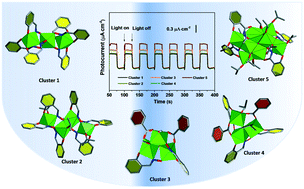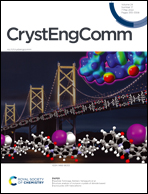A family of oxime-based titanium-oxo clusters: synthesis, structures, and photoelectric responses†
Abstract
Crystalline titanium-oxo clusters have received extensive attention as the model compounds of TiO2 materials. Functional ligands are one of the most significant factors related to their structural diversity and potential applications. Oximes have been proven to exhibit promising performances in coordination chemistry. However, the oxime-based titanium complexes have received little attention. Herein, five novel oxime-based titanium-oxo clusters, namely, Ti3(L1)6·CH2Cl2 (1, H2L1 = salicylaldoxime), Ti4(OiPr)4(L1)6 (2), Ti3(OCH3)3(BA)2(L1)2 (3, BA = benzoic acid), Ti3(μ3-O)(OiPr)2(BA)2(L1)3 (4), and Ti8(μ2-O)2(μ3-O)2(OiPr)12(L2)4 (5, H3L2 = salicylhydroxamic acid), were successfully synthesized and characterized. The coordination of the oxime ligands can effectively promote the visible light absorption of the obtained oxime-based Ti-oxo clusters. As electrode precursors for photoelectric responses, these obtained Ti-oxo clusters display clear photocurrent responses. Moreover, the salicylhydroxamic acid-based Ti-oxo cluster exhibits higher photoelectric activity than salicylaldoxime-based Ti-oxo clusters. This work not only provides new insights for verifying the effect of functional ligands on light absorption of titanium-oxo materials, but also paves the way for the design of novel titanium-based photoelectrode materials.



 Please wait while we load your content...
Please wait while we load your content...